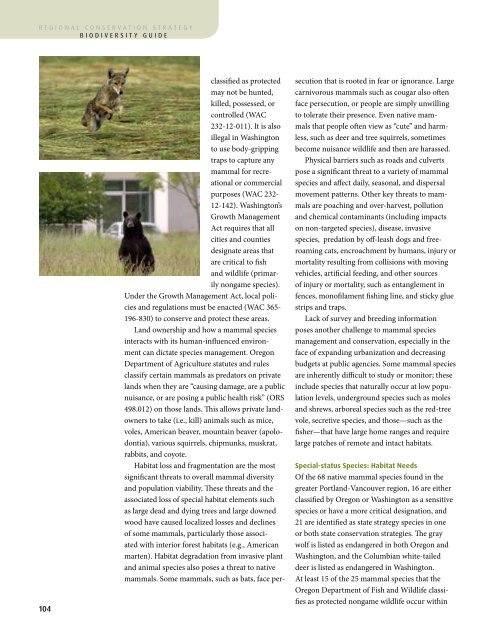Biodiversity Guide - The Intertwine
Biodiversity Guide - The Intertwine
Biodiversity Guide - The Intertwine
Create successful ePaper yourself
Turn your PDF publications into a flip-book with our unique Google optimized e-Paper software.
egional conservation strategybiodiversity guideChapter 5 Fish and Wildlife of the Regionclassified as protectedmay not be hunted,killed, possessed, orcontrolled (WAC232-12-011). It is alsoillegal in Washingtonto use body-grippingtraps to capture anymammal for recreationalor commercialpurposes (WAC 232-12-142). Washington’sGrowth ManagementAct requires that allcities and countiesdesignate areas thatare critical to fishand wildlife (primarilynongame species).Under the Growth Management Act, local policiesand regulations must be enacted (WAC 365-196-830) to conserve and protect these areas.Land ownership and how a mammal speciesinteracts with its human-influenced environmentcan dictate species management. OregonDepartment of Agriculture statutes and rulesclassify certain mammals as predators on privatelands when they are “causing damage, are a publicnuisance, or are posing a public health risk” (ORS498.012) on those lands. This allows private landownersto take (i.e., kill) animals such as mice,voles, American beaver, mountain beaver (apolodontia),various squirrels, chipmunks, muskrat,rabbits, and coyote.Habitat loss and fragmentation are the mostsignificant threats to overall mammal diversityand population viability. <strong>The</strong>se threats and theassociated loss of special habitat elements suchas large dead and dying trees and large downedwood have caused localized losses and declinesof some mammals, particularly those associatedwith interior forest habitats (e.g., Americanmarten). Habitat degradation from invasive plantand animal species also poses a threat to nativemammals. Some mammals, such as bats, face persecutionthat is rooted in fear or ignorance. Largecarnivorous mammals such as cougar also oftenface persecution, or people are simply unwillingto tolerate their presence. Even native mammalsthat people often view as “cute” and harmless,such as deer and tree squirrels, sometimesbecome nuisance wildlife and then are harassed.Physical barriers such as roads and culvertspose a significant threat to a variety of mammalspecies and affect daily, seasonal, and dispersalmovement patterns. Other key threats to mammalsare poaching and over-harvest, pollutionand chemical contaminants (including impactson non-targeted species), disease, invasivespecies, predation by off-leash dogs and freeroamingcats, encroachment by humans, injury ormortality resulting from collisions with movingvehicles, artificial feeding, and other sourcesof injury or mortality, such as entanglement infences, monofilament fishing line, and sticky gluestrips and traps.Lack of survey and breeding informationposes another challenge to mammal speciesmanagement and conservation, especially in theface of expanding urbanization and decreasingbudgets at public agencies. Some mammal speciesare inherently difficult to study or monitor; theseinclude species that naturally occur at low populationlevels, underground species such as molesand shrews, arboreal species such as the red-treevole, secretive species, and those—such as thefisher—that have large home ranges and requirelarge patches of remote and intact habitats.the region. In Oregon, these species may not behunted, trapped, pursued, killed, caught, angledfor, or possessed, whether dead or alive, whole orin part (OAR 635-044-0130) (see Appendix E).Several special-status species (e.g., Americanmarten, fisher, red tree vole) need large patchesof intact, late successional mixed conifer habitatswith multi-layered canopies. <strong>The</strong>se species needa high density of snags and logs for den sites andforaging and typically have low survival ratesin fragmented forests. <strong>The</strong> red tree vole, whichoccurs only in western Oregon and northernCalifornia, has a small home range but requirestree-top connectivity for post-breeding dispersal;this species. A recent U.S. Fish and Wildlife Servicedecision listed the North Oregon Coast redtree vole population, whose range includes thewestern portion of the greater Portland-Vancouverregion, as a distinct population segment; thispopulation is a candidate for federal EndangeredSpecies Act listing.<strong>The</strong> Columbian white-tailed deer is a federallylisted species that historically occurred throughoutColumbia River bottomland hardwoodforests. Now only remnant populations occur inriparian habitats on remaining islands along thelower Columbia River.Many of the region’s special-status species arebats. Although many bat species are known to usehuman structures such as crevices in bridges forroost sites, bats within the greater Portland-Vancouverregion typically are associated with matureforests and will use large snags, hollow trees, anddowned wood for roost sites.Data Gaps<strong>The</strong>re are knowledge gaps for many of the mammalspecies that occur within the greater Portland-Vancouverregion, particularly for nongameand special-status species. Additional informationon basic species distribution, population densitiesand trends, dispersal patterns, seasonal movements,overwintering locations and the level ofhuman-caused mortality would improve conservationefforts for mammals within the region andacross species’ ranges.Conservation Strategiesn Prevent additional habitat fragmentationwithin the region, both in developed areas andtoward the outer fringes of the region.n Improve habitat connectivity within the regionand with key habitat areas outside the region.n Incorporate the needs of wildlife when implementingculvert replacement and fish passageprojects, to allow animal movement.n Develop and use measurable indicators ofhigh-quality habitats.n Evaluate the effectiveness of providing passagearound barriers to mammal movement, toenhance species migration and habitat connectivity.n For species that depend on habitats that alreadyhave a high degree of fragmentation or isolation,determine the patch sizes and configurationneeded to maintain viable populations.n Complete conservation assessments for specialstatusspecies that summarize status, life history,threats, and conservations strategies.n Fill species data gaps, focusing on the highestpriority special-status species first.n Determine the impacts of introduced mammalspecies (i.e., nutria, eastern fox squirrel, easterngray squirrel, eastern cottontail rabbit, Virginiaopossum) on native wildlife.n Control invasive plant species to address habitatdegradation.n Develop new cost-effective and efficient techniquesfor studying species that are elusive ordifficult to study.n Enact harsher penalties (e.g., fines) for wildlifecrimes.Special-status Species: Habitat NeedsOf the 68 native mammal species found in thegreater Portland-Vancouver region, 16 are eitherclassified by Oregon or Washington as a sensitivespecies or have a more critical designation, and21 are identified as state strategy species in oneor both state conservation strategies. <strong>The</strong> graywolf is listed as endangered in both Oregon andWashington, and the Columbian white-taileddeer is listed as endangered in Washington.At least 15 of the 25 mammal species that theOregon Department of Fish and Wildlife classifiesas protected nongame wildlife occur within104 105




